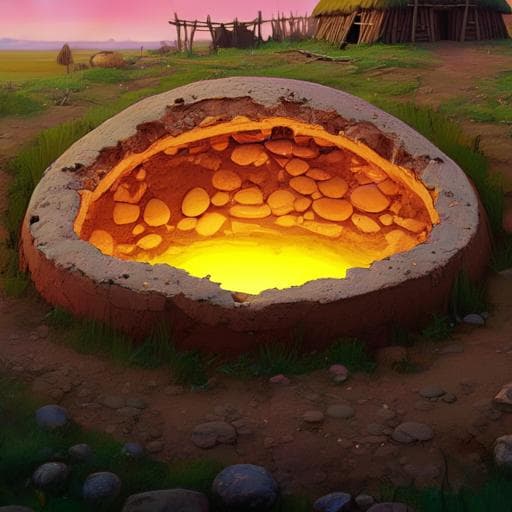
Interdisciplinary Studies
Tomorrow's mundane is today's extraordinary: A case study of a plastered installation during Neolithization
L. Grosman, T. Raz, et al.
Discover the fascinating journey of Neolithization in the Southern Levant as Leore Grosman, Timna Raz, and David E. Friesem unveil an extraordinary plastered installation from the Late Natufian village of Nahal Ein Gev II. Through advanced micro-geoarcheological techniques, this study sheds light on the innovative cultural transformations that led to the emergence of Neolithic storage solutions.
~3 min • Beginner • English
Introduction
Archaeological research often centers on frequent, ordinary artifacts that define cultural entities statistically, but the extraordinary—objects or features that deviate from the norm in form, context, or time—can illuminate special worldviews and behavioral changes. Here, extraordinary is defined as an early occurrence of phenomena that later become common; focusing on low-frequency occurrences provides a window into their emergence. The Neolithization of the Southern Levant, a long-term socio-cultural evolution from the Epipaleolithic into the Late Neolithic, involved increased sedentism, population density, technological shifts, and ritual change, culminating in agricultural villages. During the Natufian (15,000–11,500 calBP) many elements of later Neolithic life emerged: permanent architecture, on-site burials, heavy-duty food-processing tools, and larger, denser sites, while lithic technology still retained Epipaleolithic microlithic traditions. Notably, sickle blades indicative of plant harvesting become a hallmark of Natufian toolkits, foreshadowing farming. Another key phenomenon is lime plaster production: incipient during the Epipaleolithic, with a technological leap by the end of the Natufian enabling large-scale high-quality lime plaster, though widespread, standardized lime plaster becomes mundane only in the PPNB. The study presents a structured, plastered pit (Feature 6) from the Late Natufian village of Nahal Ein Gev II (NEG II) as a case of an extraordinary feature in its time that anticipates later Neolithic storage installations. The research question asks what the original function of Feature 6 was and how its characteristics inform the gradual emergence of storage practices during Neolithization.
Literature Review
Earliest putative storage installations in the Near East have been proposed for the Early Natufian at 'Ain Mallaha (Eynan), where several plastered pits were reported, though interpretations remain debated. In the Late Natufian, one slab-paved pit with barley seeds was found at Hayonim Terrace, and a few small installations at Nahal Oren have been interpreted as potential silos; however, overall the Late Natufian lacks unequivocal storage features, and some scholars argue that substantial food storage was absent for about 1200 years before the start of the Neolithic. From the PPNA onward, evidence for storage becomes more regular: clay-plastered bins similar in size to Feature 6 at Netiv Hagdud; larger semi-subterranean clay storage installations at Wadi Faynan 16; and 3 m granaries with suspended floors at D'hra, likely for wild plant storage predating full domestication. In the Middle PPNB, storage within houses becomes prominent: a mud-plastered bin at Yiftahel contained about 2000 fava beans, with lentils nearby, and similar installations were found in Jericho. At 'Ain Ghazal, curved stone wall niches likely served storage and contained peas, lentils, and barley. In the Late PPNB, dedicated storage rooms appear (e.g., Basta, Es-Sifyia), and large rounded dried-clay containers likely used as silos were found at 'Ain Ghazal. By the Late Neolithic/Early Chalcolithic (ca. 7000 BP) at Tel Tsaf, multiple silos provide direct evidence for cereal storage, with construction principles for long-term preservation; a clay model of a silo from the site resembles a domed, bag-shaped jar similar to the reconstructed shape of Feature 6. The domed, plaster-lined, semi-subterranean design offers cool, relatively airtight conditions suitable for long-term grain storage.
Methodology
Study area and context: Feature 6 is a round, plastered installation at NEG II, a Late Natufian site dated 12,550–12,000 calBP, located on an alluvial terrace near Wadi Ein Gev. Feature 6 (~80 cm diameter; preserved depth ~50 cm) was dug into virgin soil beneath Structure 3, placing it in the early occupation phase. The walls show alternating layers of brown-red earthen plaster with white inclusions and white-gray plaster; at least three plastering episodes are visible. The interior was filled with heterogeneous sediments. Sampling: Archeological samples included wall materials (n=4), an additional plaster sample inside the installation (n=1), and infill sediments representing different fill types/depths (n=5). One undisturbed monolithic block from the center of the installation (NEG 15-1) was collected for micromorphology. Control samples (n=4) were collected from a terrace beyond the site: two from a pit (topsoil and 10 cm depth) and two from a terrace wall (10 and 20 cm depth). Heating experiment: Control terrace sediments (3–5 g; stones removed; homogenized) were heated in a furnace at 300, 500, and 700 °C for 1 hour in ceramic crucibles to establish FTIR reference patterns for pyrogenic alteration. FTIR spectroscopy: All samples (archeological and control; total n=14) were powdered and analyzed using a Nicolet iS5 (Thermo Scientific) in transmission mode via the KBr method. Spectra were collected 4000–250 cm−1, 4 cm−1 resolution, 32 scans. Clay alteration due to heating (>500 °C) was assessed by loss of hydroxyl-associated absorption bands at 3695, 3650, 3620, and 915 cm−1 and by shifts in the main silicate absorption band (1030–1040 cm−1). The main silicate band location was plotted against its width at 66% height (MSW) to gauge heating intensity. Atomic disorder in calcite was evaluated as a proxy for pyrogenic lime, using reference data for NEG II lime plaster. Micromorphology: The monolith was dried (50 °C, 3 days), impregnated with polyester resin/acetone (9:1) plus 1% MEKP, cut (66 × 140 mm), and ground to 30 µm thin section. Analysis used a petrographic microscope (×4–×400) with plane- and cross-polarized light. Descriptions follow Stoops (2003).
Key Findings
- Feature characteristics: Round pit (~80 cm diameter), preserved depth ~50 cm (floor at ~level 700; walls preserved to ~650 west, 670 east). Alternating wall layers of brown-red earthen plaster and white-gray plaster; at least three plastering episodes; inner brown-red massive layer transitioning to gray outer layers. Interior wall/floor covered by a hard brown sediment with small fist-sized stones attached. The infill is heterogeneous: upper levels with brown-red hard crumbly sterile patches (mainly SE) and gray powdery sediment rich in flint/fauna with many pebbles/angular stones (NW), with diffuse boundaries; below, a patchy layer of plaster fragments; beneath that, homogeneous gray, loose anthropogenic sediment with stones (5–30 cm), flint, and bone; floor includes plaster layers similar to walls topped by flat stones.
- FTIR results (n=14): Archeological samples (walls and fills) show no clay band shifts or OH-band loss indicative of heating ≥500 °C; all cluster with unaltered/low-heating controls in the clay location vs. MSW plot. Most samples show calcite with atomic order characteristic of natural CaCO3; exceptions are white plaster from the pit walls and a few white-gray aggregates in the infill showing relatively high atomic disorder consistent with pyrogenic lime plaster. Interpretation: wall white plaster is lime plaster; some lime plaster fragments in fill likely derive from wall collapse.
- Micromorphology (center infill thin section): Top shows light-colored crumbly sediment with fragments of brown (mud plaster) and white-gray (lime plaster) adhered to each other (wall plaster debris). Below lies gray-brown sediment with flint and bone fragments of varying colors. The matrix is open and poorly sorted, including quartz (~15%), large limestone fragments, bones and flint (~10%), microcharcoal, shells, organic matter, and poorly preserved ash (<5%). Upper part contains large mud-plaster fragments with planar voids (shrinkage fractures) and darker clay color, characteristic of earthen construction material; mud plaster is sometimes attached to lime plaster fragments. Fire residues (burnt bone, carbonized aggregates, rubified clay aggregates, charred organics, few partly preserved ash) are dispersed, without bedding or concentration, indicative of secondary dumping rather than in situ activity.
- Functional inference: Absence of heat alteration in wall clays rules out use as kiln or fire-based cooking installation. The chaotic, mixed anthropogenic infill with secondary fire residues indicates the pit was later used as a refuse bin or left to fill after abandonment. Architectural form (plastered, possibly domed, semi-subterranean pit) closely resembles later Neolithic storage installations.
- Cultural significance: No known Natufian parallels for a lime-and-clay plastered installation like Feature 6; such features become common during Neolithization as storage installations for cereals/legumes. Feature 6 is extraordinary for the Late Natufian and likely heralds the development of clay-lined storage installations.
Discussion
Micro-geoarchaeological evidence shows Feature 6’s walls were not exposed to high temperatures, excluding kiln or fire-based cooking functions. The infill is a mixed, secondary deposit of local sediments and anthropogenic debris, including dispersed fire residues, consistent with post-use dumping. Architecturally, the semi-concave upper wall profile suggests a dome-like cover; alternating applications of mud and lime plaster indicate significant investment and maintenance uncommon at NEG II domestic features. This design strongly parallels PPNA–PPNB storage bins and silos known to have stored cereals and legumes. Although direct botanical evidence is absent, the form and construction imply a likely storage function, either for wild plants or other materials. Within the broader trajectory of Neolithization, Feature 6 represents an early, rare occurrence of a feature that later becomes widespread and mundane, illustrating how incremental innovations appear as extraordinary at their inception. Its uniqueness in the Natufian record (with only limited, debated parallels at 'Ain Mallaha and Hayonim Terrace and none with combined lime and earthen plaster) underscores a genuine early step toward storage technologies integral to later farming societies.
Conclusion
Feature 6 at NEG II is a round, plastered, semi-subterranean installation with alternating mud and lime plaster layers that shows no evidence of heating of wall clays and contains a secondary, mixed anthropogenic infill. These results rule out kiln or fire-based cooking functions and, together with the installation’s architecture, point to a likely storage purpose. As such, Feature 6 is extraordinary within the Late Natufian context and foreshadows the emergence of clay-lined storage installations that become commonplace during the Neolithic. Methodologically, defining extraordinary as an early occurrence in a frequency trajectory, and applying micro-geoarchaeological tools (FTIR, micromorphology), refines our ability to detect subtle steps in cultural innovation. Future research will target identifying the original stored contents and further integrating microarchaeological data to resolve function.
Limitations
- The installation’s interior is filled with secondary, heterogeneous sediments, obscuring primary activity residues and preventing unequivocal functional identification.
- No direct botanical evidence (e.g., preserved seeds) was recovered from the feature to confirm storage use.
- Wall collapse contributed lime plaster fragments to the infill, complicating stratigraphic interpretation.
- Preservation biases and erosion (differential wall heights) limit complete reconstruction of original architecture (e.g., certainty about a dome).
Related Publications
Explore these studies to deepen your understanding of the subject.







